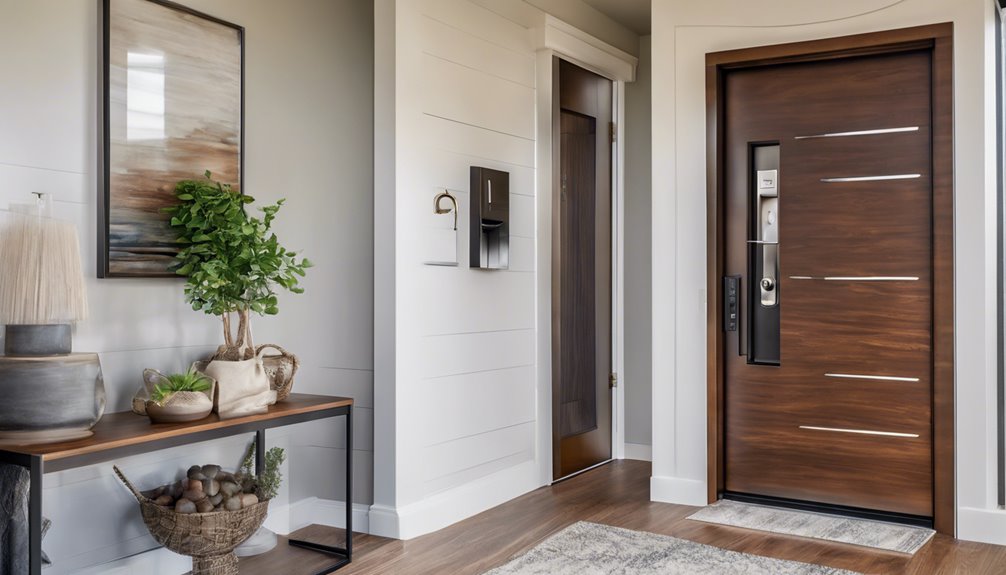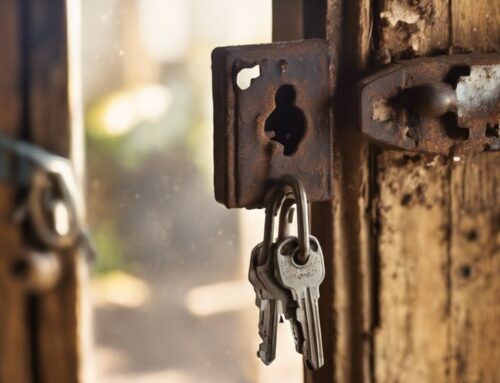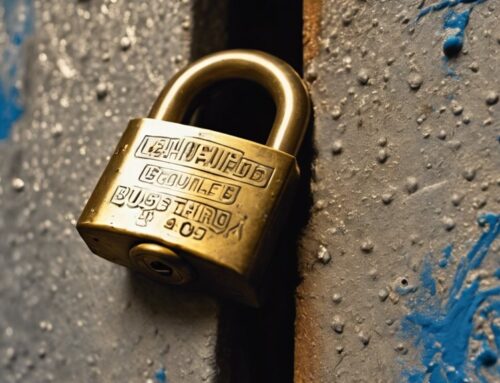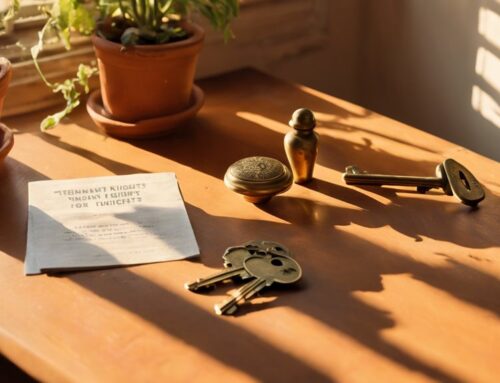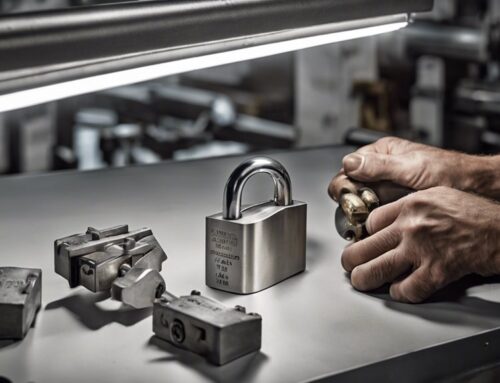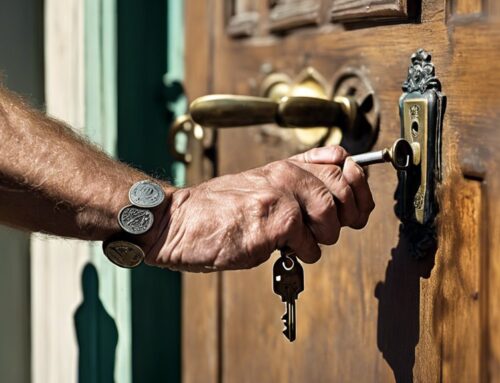When you're considering the installation of digital or smart locks in Ohio, it's important to understand the legal framework that governs these devices. You need to guarantee compliance with the Ohio Building Code, which covers everything from hardware specifications to safety standards. Local authorities play a key role in enforcing these regulations, but the landscape is shifting, especially as privacy concerns regarding data security come to the forefront. What implications might these evolving laws have on your ability to securely lock your home?
Key Takeaways
- Smart locks must comply with the Ohio Building Code, verifying specific hardware requirements outlined in Section 1010.1.9.1.
- Lock installations must follow manufacturer instructions to ensure proper operation and compliance with safety standards.
- Digital locks require visible indicators to confirm they are locked for enhanced user safety and compliance.
- Local authorities oversee the installation and operation of smart locks, ensuring adherence to security regulations.
- Regular power checks for electronic locks are necessary to maintain compliance with Ohio law and safety standards.
Overview of Ohio Lock Regulations
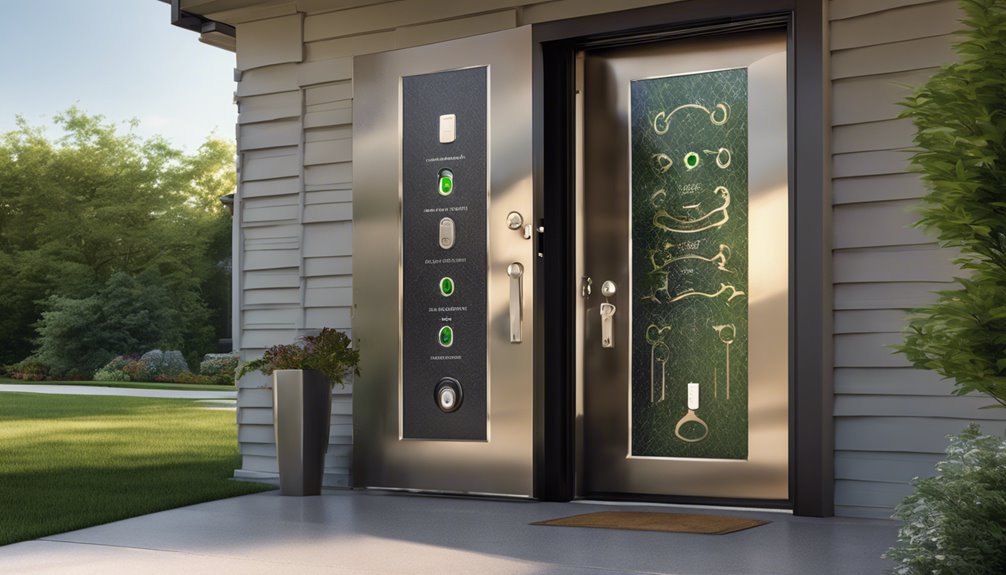
When examining Ohio lock regulations, it's evident that the focus is primarily on traditional locking mechanisms designed to guarantee safety and security in both residential facilities and apartment buildings.
The regulations mandate that locks on doors to rooms or storage areas where children might be confined must be operable without a key from both sides. This requirement underscores a commitment to child safety while balancing the need for secure environments. Additionally, compliance measures are important in ensuring the effectiveness of these safety protocols.
In apartment buildings, swinging exit doors must feature deadbolts or equivalent locking devices that comply with the Ohio Board of Building Standards. This regulation assures residents can safely exit in emergencies.
Significantly, these rules have been effective since 1975, emphasizing a long-standing dedication to security. Additionally, smart locks are part of the broader smart home device trend that has gained popularity among residents.
Furthermore, bedroom doors within facilities must have locks allowing occupants to exit without a key. Such provisions aim to empower residents while maintaining a secure atmosphere.
However, when it comes to smart or digital locks, Ohio's regulations fall short; there's no specific guidance addressing their use or security protocols.
The absence of specific rules for smart locks contrasts sharply with other states that regulate smart lock data and privacy concerns.
Consequently, while traditional locks are clearly outlined in Ohio law, the lack of regulations for digital methods may leave users vulnerable.
As you consider your locking options, it's crucial to remain aware of these regulatory gaps and assess how they align with your security expectations and personal freedom in residential settings.
Temporary Door Locking Devices
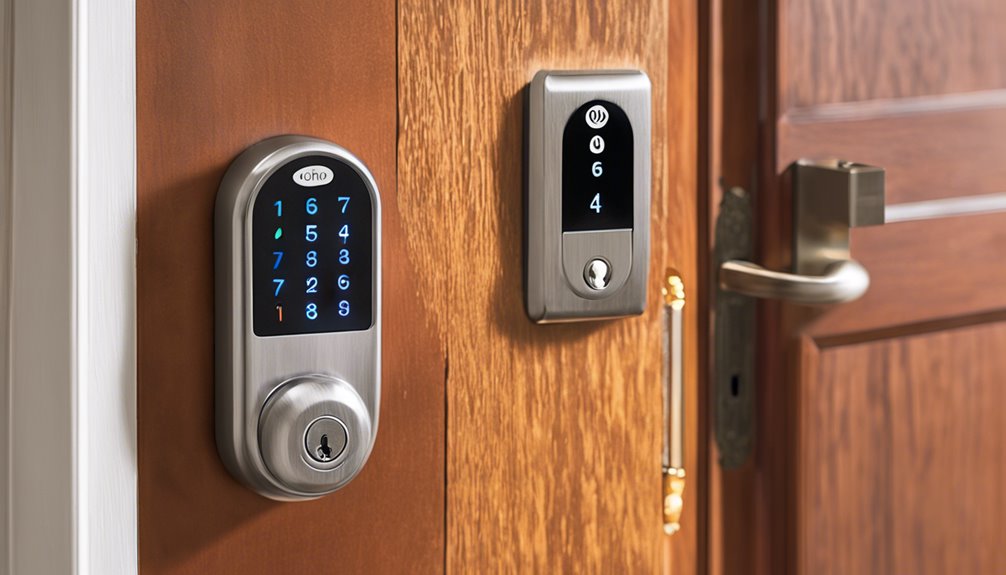
When considering temporary door locking devices in Ohio, you must understand the approval process and specific emergency use guidelines. Compliance with state regulations is essential, as you need to guarantee adherence to safety plans and operational requirements. Additionally, the use of these devices is permitted only in emergency situations, ensuring that they are engaged responsibly and effectively. This framework helps maintain security while allowing for timely responses during emergencies. Landlords must be aware of legal guidelines regarding changing locks after eviction to ensure they proceed within the law. It is crucial for landlords to recognize that tenants have the right to secure their premises, reinforcing the need for diligence in following legal procedures when altering locks.
TDLD Approval Process
To guarantee the effective use of Temporary Door Locking Devices (TDLDs) in schools, an application must be submitted to the relevant building department for approval. This application is vital to confirm safety and compliance with state regulations.
Your application should include the following key elements:
- Evidence of a properly adopted and filed school safety plan.
- A statement confirming that police and fire officials have been notified about the proposed TDLD use.
- A thorough description of the proposed TDLD.
- Confirmation that any installed components don't compromise the door's fire rating.
The building official will evaluate your TDLD to verify it adheres to operational requirements. Remember, only devices that can be removed with one operation are typically approved, unless special exceptions apply. Notably, the Ohio Board of Pharmacy has established new licensing requirements that may impact safety protocols. Additionally, these requirements highlight the need for compliance with lock picking laws to ensure the safe and effective implementation of security devices. An understanding of regulatory compliance can significantly aid in meeting these guidelines effectively.
Training for school staff on using TDLDs is also essential, and you'll need to maintain documentation of this training.
Consulting legal counsel regarding accessibility requirements could further enhance your compliance efforts, safeguarding both safety and freedom for all users.
Emergency Use Guidelines
The use of Temporary Door Locking Devices (TDLDs) is strictly regulated to secure safety during emergencies and active shooter drills. These devices can only be engaged by authorized staff and after notifying police and fire officials. Vital conditions must be met, including proof of an adopted school safety plan and a finite engagement period as specified by school authorities. Understanding these employment laws is essential for ensuring compliance and safety.
Here's a breakdown of key aspects:
| Conditions | Operational Requirements |
|---|---|
| Emergency use only | Not permanently mounted, with exceptions |
| Staff engagement only | Removal requires minimal operations |
| Police/fire notification needed | Accessible removal from outside |
| Safety plan proof required | Must comply with ADA (outside building code) |
| Training documentation mandatory | Variances available through appeals |
Following these guidelines guarantees that TDLDs effectively contribute to the safety of students and staff during crises while adhering to legal requirements. Your understanding and compliance with these rules are vital for creating a secure environment. Always stay informed about the operational specifics and consult appropriate legal counsel when necessary. Additionally, locksmiths must consider Ohio's key duplication laws when installing these devices to ensure they align with security standards.
Compliance Requirements Overview
Understanding the compliance requirements for Temporary Door Locking Devices (TDLDs) is vital for maintaining safety in educational settings. These devices must meet various legal and operational standards to guarantee they function effectively without compromising safety.
Here are key points to take into account:
- Proof of an adopted school safety plan must be filed as per Ohio Revised Code.
- TDLDs require approval from the building official before installation.
- All police and fire officials must be notified prior to their use.
- Only staff members can engage the device.
Operationally, TDLDs can't be permanently mounted or obstruct normal door access, nor affect the fire rating of the door assembly. Records of in-service training on device usage must be retained and available upon request. Additionally, it is essential that TDLDs comply with high-security lock standards to enhance safety and protection.
Approval involves a thorough application process, and non-compliances must be addressed urgently based on feedback from building officials. Additionally, it is crucial to ensure that the installation does not interfere with other licensed and insured services provided by professional locksmiths.
While TDLDs aren't strictly governed by the Americans with Disabilities Act (ADA), it's important to consult legal counsel to verify no other ADA provisions are violated. By adhering to these compliance requirements, you can effectively utilize TDLDs while promoting safety and accessibility in schools.
Compliance With Building Codes
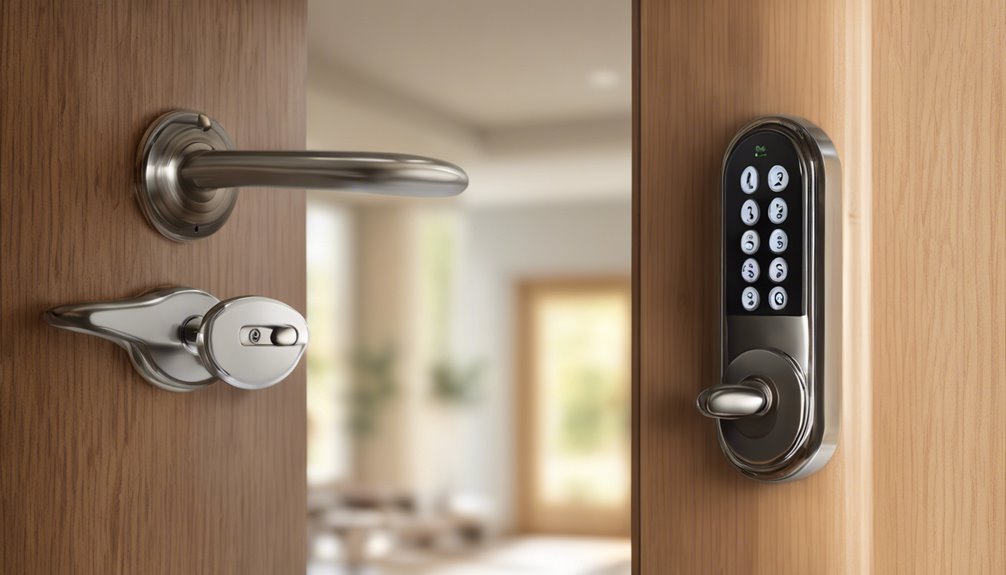
While implementing digital and smart locks in Ohio, it's crucial to guarantee compliance with the Ohio Building Code. This code sets forth hardware requirements for devices like door handles and locks to confirm user safety and accessibility. Understanding and adhering to these regulations will simplify the installation process and enhance the security of your premises. Additionally, locksmiths play a vital role in real estate transactions throughout Ohio, ensuring that installations comply with legal standards.
| Requirement | Details | Compliance Action |
|---|---|---|
| Hardware Requirements | Must comply with Section 1010.1.9.1 | Verify lock specifications before purchase |
| Lock Distinction | Locking devices must be visibly locked | Install clear indicators on all locks |
| Installation Standards | Follow manufacturer's instructions | Conduct thorough testing post-installation |
| Electronic Lock Power Requirements | Confirm compatible electrical connections | Schedule regular battery checks if applicable |
Each locking device you choose should require no tight grasping, pinching, or wrist twisting for operation. Existing structures may permit thumb turn or key locking devices under certain conditions. It's critical to include signage indicating doors that remain unlocked during occupancy.
Professional installation is strongly advised for electronic locking systems, included in compliance with NFPA and ADA standards. Working with qualified technicians guarantees that your systems meet local building codes, facilitating regulatory approval. Finally, integrating audit trails and transaction logging into your access control systems confirms that user access remains monitored and secure.
Accessibility Considerations
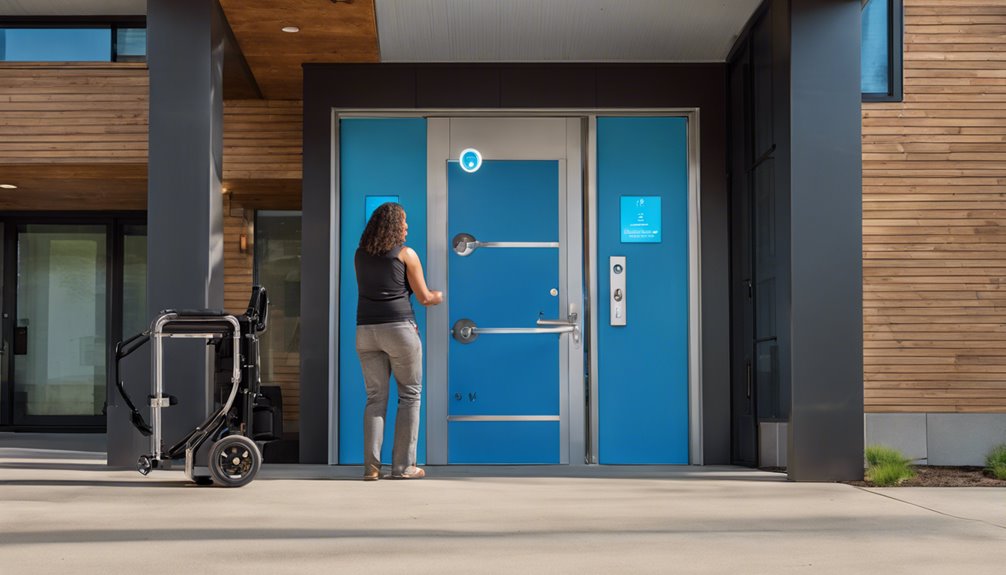
When considering digital and smart locks, you must guarantee compliance with ADA requirements to provide equal access for all individuals, including those with disabilities.
Integrating accessible features in your lock systems not only meets legal standards but also enhances usability for a wider audience.
Addressing these considerations proactively can prevent potential legal issues and promote inclusivity.
ADA Compliance Requirements
To comply with ADA standards, it's essential that digital and smart locks are designed with accessibility in mind. This guarantees that all individuals, regardless of ability, can use them effectively.
Key requirements include:
- Mounting Height: Operable parts must be between 34 and 48 inches off the ground.
- One-Hand Operation: Locks should be operable with one hand without requiring tight grasping or twisting.
- Force Requirement: Activation force mustn't exceed 5 pounds.
- Reach and Clearance: Guarantee unobstructed reach for users with disabilities.
In various settings, such as public buildings, workplaces, and multi-unit housing, compliance with these specifications is critical.
Digital locks featuring keyless entry are highly favored for easing access, while also eliminating physical keys that may not meet operable part standards. Additionally, incorporating visual and audible indicators helps accommodate users with vision or hearing impairments, further enhancing accessibility.
Guaranteeing ADA compliance isn't just a regulatory obligation but a commitment to creating inclusive environments where freedom of access is prioritized for everyone.
The attention to these requirements can greatly improve the user experience and safeguard against legal penalties.
Accessibility Features Integration
Integrating accessibility features with smart lock systems is vital to guarantee that all users, including those with disabilities, can navigate spaces effectively. While Ohio law doesn't specifically address smart locks, these devices must fit within the broader accessibility strategy for buildings. You must make certain that smart locks don't create barriers, thereby fostering an inclusive environment.
When altering existing structures, remember that adjustments should comply with accessibility routes, ideally covering accessible entrances first. Your planning should account for users' needs, making sure that entrances function harmoniously with smart lock technology. For instance, doors that swing towards the right-of-way need to be recessed correctly to comply with building regulations, promoting ease of access.
Although the Ohio Building Code lacks explicit guidelines for smart locks, a commitment to general accessibility principles remains essential. Make sure proper signage directs individuals to accessible entrances.
Document any instances of technical infeasibility, enabling reasonable accommodations during the design and installation of smart lock systems. By incorporating these considerations, you guide your project toward an inclusive outcome, empowering everyone to access spaces freely and effectively.
Installation and Approval Process
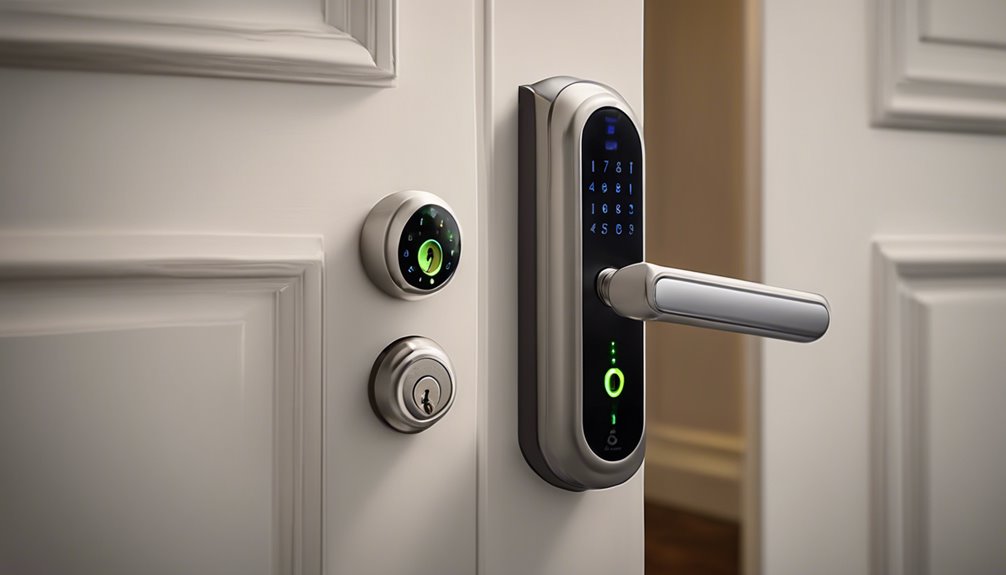
Although Ohio law doesn't specifically address smart locks, the installation of security devices must still adhere to established building standards. For you, this means that any lock installation requires compliance with the relevant codes and standards set forth by the Ohio Board of Building Standards.
Here's what you need to know about the installation and approval process:
- Compliance with General Standards: All locking devices, including smart locks, must meet the building standards outlined in the Ohio Revised Code.
- Approval of Plans: Before you can customize or alter any installation, you must guarantee your building plans get approved by the Ohio Department of Commerce's Building Code Compliance (BCC).
- Field Inspections: Expect field inspections aimed at confirming that your installation meets the mandated building standards.
- Local Jurisdiction Regulations: Be aware that your local authorities may impose additional requirements that apply directly to smart lock installations.
Because Ohio law lacks specific guidelines for smart locks, it's essential for your installations to follow broader general building codes.
This regulatory gap means you're relied upon to navigate existing standards carefully while considering local regulations.
If you're planning alterations, remember that applications for construction must be processed and approved, which will guarantee compliance with safety and housing standards in both multi-unit dwellings and individual residences.
Prioritize understanding these processes to protect your tenants' security in an evolving digital landscape.
Security Features of Smart Locks
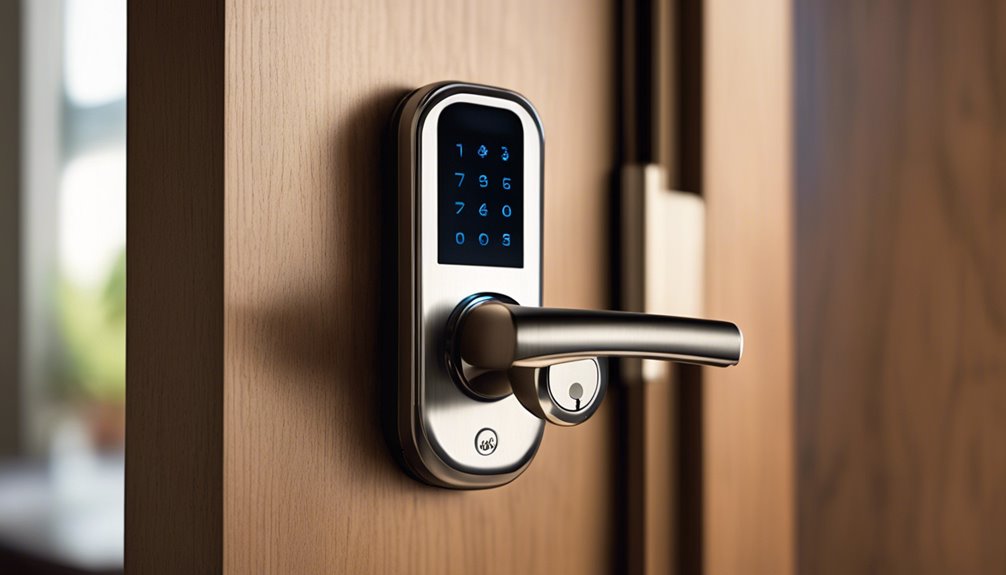
As smart locks become more prevalent, understanding their security features is essential for ensuring your property is adequately protected. One vital aspect is data storage and privacy. Smart locks often store fingerprint templates and access recordings locally, on an encrypted microchip, avoiding cloud servers and reducing exposure to potential breaches. By limiting data collection, these locks minimize vulnerabilities while ensuring that biometric data remains confined to a single unit.
When it comes to encryption, most smart locks employ industry-standard protocols like SSL and AES-128 for end-to-end encryption. This secures remote communications between lock components, making it incredibly difficult for unauthorized parties to intercept or understand any captured data. Additionally, login information is masked and encrypted, adding another layer of protection against unauthorized access.
Biometric authentication options enhance security further. Features such as facial recognition and fingerprint verification leverage unique biological traits to confirm identity. Many smart locks offer multi-factor authentication, combining biometric data with additional verification methods like PIN codes. If biometric methods fail, alternative access options, like app controls or mechanical keys, are readily available.
Finally, remote access and monitoring capabilities allow you to manage your smart locks from anywhere, thanks to Wi-Fi and Bluetooth connectivity. You can view activity logs, set alerts, and create virtual guest keys seamlessly.
Integrating these locks with smart home devices offers even more command and convenience, strengthening your property's security while preserving personal freedom.
Role of Local Authorities
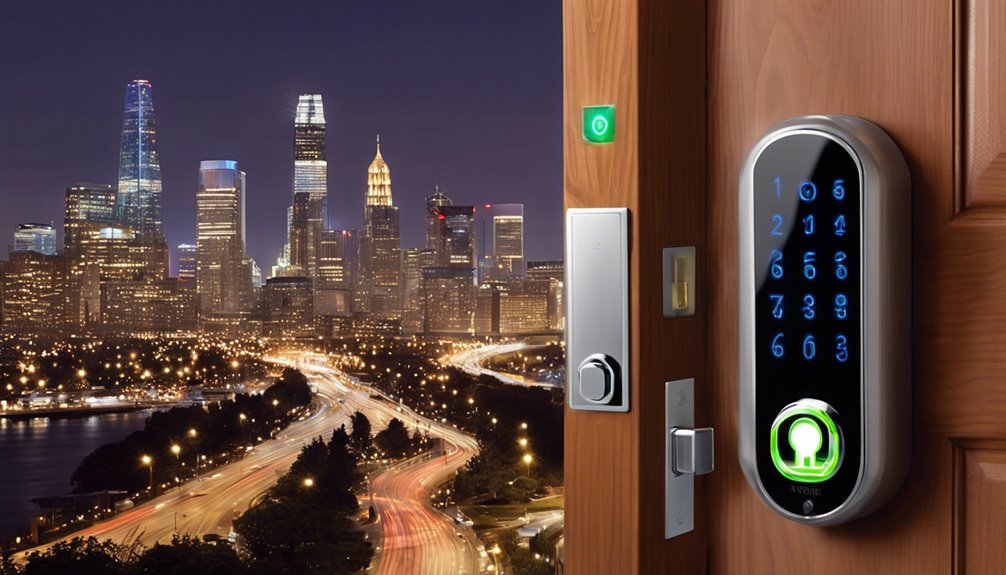
Local authorities play an essential role in regulating the installation and operation of digital and smart locks to guarantee safety and compliance with state building codes. These local entities assure that all installations align with the Ohio Board of Building Standards and that property owners maintain the required safety measures.
Key responsibilities include:
- Enforcing building codes to assure security locking devices meet the prescribed standards.
- Overseeing installation requirements, assuring compatibility and adherence to manufacturer instructions.
- Conducting inspections to verify compliance with regulations and identifying potential violations.
- Providing guidelines and resources to assist property owners in meeting regulatory measures.
Local authorities have the responsibility to mandate specific installation procedures, verify electrical connections, and assure that selected locks are suitable for the doors they're applied to. This oversight helps not just in compliance but also in enhancing tenant protection, as local regulations may evolve to include privacy measures related to smart lock data.
While local authorities impose penalties for non-compliance, they also support tenants' rights by considering regulations that safeguard against data misuse.
Ultimately, their role is pivotal in balancing safety, compliance, and individual freedoms, assuring that advancements in lock technology don't compromise the security we expect in our dwellings.
Frequently Asked Questions
Are There Additional Requirements for Residential Digital Lock Installations?
When considering residential digital lock installations, you should guarantee compliance with safety and security standards.
These locks must meet building codes and be accessible for all, especially in child-protection areas.
Look for features preventing brute force attacks and those managing vulnerability reports.
Additionally, verify that the system's firmware can be updated and that it offers audit trails to monitor access attempts.
Proper installation and adherence to best practices are essential for effective security.
How Do I Report Non-Compliance With Lock Regulations?
To report non-compliance with lock regulations, start by reaching out to local law enforcement or housing authorities, as they may handle safety concerns.
Also, consider contacting consumer protection agencies for guidance.
However, be aware that specific protocols for smart locks aren't established.
You might explore industry standards or self-regulatory practices, but they lack legal authority.
Ultimately, Ohio needs clearer regulations to enhance reporting mechanisms for these installations.
Can I Install Smart Locks Without Prior Approval?
Yes, you can generally install smart locks without prior approval, especially in residential settings.
However, make certain your installation complies with local building codes and regulations. If you're modifying an existing structure or undertaking significant renovations, check if approval is required.
Additionally, remember that smart locks must meet safety and accessibility standards. Always verify your local regulations to avoid any compliance issues later on.
What Penalties Exist for Non-Compliance With Lock Regulations?
Picture yourself standing before a door, secure behind the right locks.
If you fail to comply with lock regulations, you risk hefty fines and possible legal action. Local authorities may press additional penalties, forcing you to make costly repairs or replacements.
Beyond financial burdens, you might face reputational damage and the hassle of legal battles.
Adhering to regulations guarantees not just security, but also peace of mind in protecting your property and rights.
Are There Specific Manufacturers Recommended for Compliant Digital Locks?
There aren't specific manufacturers recommended for compliant digital locks under Ohio law.
However, you should choose manufacturers that meet recognized cybersecurity and data protection standards like ETSI TS 103 815. By doing so, you guarantee that the digital locks you install are secure and reliable.
Local security companies can also provide insights on compliant systems based on their expertise with current codes and requirements.
Always prioritize manufacturers that adhere to industry standards.
Conclusion
In maneuvering through Ohio's regulations on digital and smart locks, it's essential to stay informed about compliance requirements and safety standards. Imagine installing a sleek smart lock, only to realize it doesn't meet local building codes, leaving your home vulnerable. By understanding these regulations and working closely with local authorities, you can guarantee that your installation not only enhances security but also aligns with legal expectations. Ultimately, adherence to these laws protects both you and your property.

